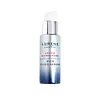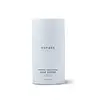What's inside
What's inside
 Key Ingredients
Key Ingredients

 Benefits
Benefits

 Concerns
Concerns

 Ingredients Side-by-side
Ingredients Side-by-side

Water
Skin ConditioningGlycerin
HumectantBetaine
HumectantPropanediol
SolventCanola Oil
EmollientVaccinium Myrtillus Fruit Juice
Skin ConditioningCaprylic/Capric Glycerides
EmollientHeptyl Undecylenate
EmollientAvena Sativa Kernel Oil
Skin ConditioningVaccinium Myrtillus Seed Oil
Skin ConditioningPhenoxyethanol
PreservativeCaprylic/Capric Triglyceride
MaskingSaccharide Isomerate
HumectantTocopherol
AntioxidantSodium Lauroyl Lactylate
EmulsifyingAcacia Senegal Gum
MaskingXanthan Gum
EmulsifyingHelianthus Annuus Seed Oil
EmollientSucrose Laurate
EmollientHydrolyzed Hyaluronic Acid
HumectantSodium Hyaluronate
HumectantEthylhexylglycerin
Skin ConditioningSodium Gluconate
Skin ConditioningLactic Acid
BufferingCeramide NP
Skin ConditioningCeramide AP
Skin ConditioningPhytosphingosine
Skin ConditioningCholesterol
EmollientCarbomer
Emulsion StabilisingCitric Acid
BufferingSodium Citrate
BufferingSodium Carrageenan
Emulsion StabilisingMaris Sal
Skin ConditioningRosmarinus Officinalis Leaf Extract
AntimicrobialCeramide EOP
Skin ConditioningWater, Glycerin, Betaine, Propanediol, Canola Oil, Vaccinium Myrtillus Fruit Juice, Caprylic/Capric Glycerides, Heptyl Undecylenate, Avena Sativa Kernel Oil, Vaccinium Myrtillus Seed Oil, Phenoxyethanol, Caprylic/Capric Triglyceride, Saccharide Isomerate, Tocopherol, Sodium Lauroyl Lactylate, Acacia Senegal Gum, Xanthan Gum, Helianthus Annuus Seed Oil, Sucrose Laurate, Hydrolyzed Hyaluronic Acid, Sodium Hyaluronate, Ethylhexylglycerin, Sodium Gluconate, Lactic Acid, Ceramide NP, Ceramide AP, Phytosphingosine, Cholesterol, Carbomer, Citric Acid, Sodium Citrate, Sodium Carrageenan, Maris Sal, Rosmarinus Officinalis Leaf Extract, Ceramide EOP
Water
Skin ConditioningCaprylic/Capric Triglyceride
MaskingButyrospermum Parkii Butter
Skin ConditioningPropanediol
SolventSodium Acrylates Copolymer
Sea Silt Extract
Skin Conditioning1,2-Hexanediol
Skin ConditioningAdenosine
Skin ConditioningBellis Perennis Flower Extract
Skin ConditioningBetaine
HumectantBiosaccharide Gum-4
Skin ConditioningBisabolol
MaskingCaprylyl Glycol
EmollientCitric Acid
BufferingEthylhexylglycerin
Skin ConditioningGlycerin
HumectantHelianthus Annuus Seed Oil
EmollientHydrolyzed Hyaluronic Acid
HumectantHylocereus Undatus Fruit Extract
Skin ConditioningLecithin
EmollientLeucojum Aestivum Bulb Extract
Skin ProtectingMannan
Olivine Extract
Skin ConditioningPentylene Glycol
Skin ConditioningSodium Citrate
BufferingTocopherol
AntioxidantTremella Fuciformis Sporocarp Extract
AntioxidantTrifolium Pratense Flower Extract
AstringentZingiber Officinale Root Extract
MaskingBenzoic Acid
MaskingBenzyl Alcohol
PerfumingPhenoxyethanol
PreservativePotassium Sorbate
PreservativeSodium Benzoate
MaskingSodium Metabisulfite
AntioxidantWater, Caprylic/Capric Triglyceride, Butyrospermum Parkii Butter, Propanediol, Sodium Acrylates Copolymer, Sea Silt Extract, 1,2-Hexanediol, Adenosine, Bellis Perennis Flower Extract, Betaine, Biosaccharide Gum-4, Bisabolol, Caprylyl Glycol, Citric Acid, Ethylhexylglycerin, Glycerin, Helianthus Annuus Seed Oil, Hydrolyzed Hyaluronic Acid, Hylocereus Undatus Fruit Extract, Lecithin, Leucojum Aestivum Bulb Extract, Mannan, Olivine Extract, Pentylene Glycol, Sodium Citrate, Tocopherol, Tremella Fuciformis Sporocarp Extract, Trifolium Pratense Flower Extract, Zingiber Officinale Root Extract, Benzoic Acid, Benzyl Alcohol, Phenoxyethanol, Potassium Sorbate, Sodium Benzoate, Sodium Metabisulfite
 Reviews
Reviews

Ingredients Explained
These ingredients are found in both products.
Ingredients higher up in an ingredient list are typically present in a larger amount.
Betaine is a common humectant (a substance that promotes retention of moisture). It's known to be gentle on the skin and can help balance hydration.
This ingredient is best for improving hydration and soothing irritated skin. Studies also show it helps even out skin tone.
Fun fact: Betaine is naturally created in the skin and body. The kind found within cosmetic products can be either plant-derived or synthetic.
Another name for betaine is trimethylglycine.
Learn more about BetaineThis ingredient is an emollient, solvent, and texture enhancer. It is considered a skin-softener by helping the skin prevent moisture loss.
It helps thicken a product's formula and makes it easier to spread by dissolving clumping compounds.
Caprylic Triglyceride is made by combining glycerin with coconut oil, forming a clear liquid.
While there is an assumption Caprylic Triglyceride can clog pores due to it being derived from coconut oil, there is no research supporting this.
Learn more about Caprylic/Capric TriglycerideCitric Acid is an alpha hydroxy acid (AHA) naturally found in citrus fruits like oranges, lemons, and limes.
Like other AHAs, citric acid can exfoliate skin by breaking down the bonds that hold dead skin cells together. This helps reveal smoother and brighter skin underneath.
However, this exfoliating effect only happens at high concentrations (20%) which can be hard to find in cosmetic products.
Due to this, citric acid is usually included in small amounts as a pH adjuster. This helps keep products slightly more acidic and compatible with skin's natural pH.
In skincare formulas, citric acid can:
While it can provide some skin benefits, research shows lactic acid and glycolic acid are generally more effective and less irritating exfoliants.
Most citric acid used in skincare today is made by fermenting sugars (usually from molasses). This synthetic version is identical to the natural citrus form but easier to stabilize and use in formulations.
Read more about some other popular AHA's here:
Learn more about Citric AcidEthylhexylglycerin (we can't pronounce this either) is commonly used as a preservative and skin softener. It is derived from glyceryl.
You might see Ethylhexylglycerin often paired with other preservatives such as phenoxyethanol. Ethylhexylglycerin has been found to increase the effectiveness of these other preservatives.
Glycerin is already naturally found in your skin. It helps moisturize and protect your skin.
A study from 2016 found glycerin to be more effective as a humectant than AHAs and hyaluronic acid.
As a humectant, it helps the skin stay hydrated by pulling moisture to your skin. The low molecular weight of glycerin allows it to pull moisture into the deeper layers of your skin.
Hydrated skin improves your skin barrier; Your skin barrier helps protect against irritants and bacteria.
Glycerin has also been found to have antimicrobial and antiviral properties. Due to these properties, glycerin is often used in wound and burn treatments.
In cosmetics, glycerin is usually derived from plants such as soybean or palm. However, it can also be sourced from animals, such as tallow or animal fat.
This ingredient is organic, colorless, odorless, and non-toxic.
Glycerin is the name for this ingredient in American English. British English uses Glycerol/Glycerine.
Learn more about GlycerinHelianthus Annuus Seed Oil is the oil derived from the seeds of a Sunflower. Sunflower seed oil is non-fragrant. It is an emollient, meaning it helps to soften the skin.
Sunflower seed oil contains many fatty acids. The fatty acids found in sunflower seeds include (from highest amount to least): linoleic acid, myristic acid, palmitic acid, stearic acid, arachidic acid, oleic acid, and linolenic acid.
These fatty acids help the skin create ceramides. Ceramides play a role in repairing the skin barrier.
Helianthus Annuus Seed Oil helps moisturize the skin. This in turn helps the skin look more rejuvenated and smoother.
Sunflowers are rich in vitamin E.
Historians believe Indigenous cultures of North America domesticated sunflowers before corn. Thus they relied on sunflower oil for a variety of uses. One such use is moisturizing skin and hair.
Sunflower seed oil may not be fungal acne safe. We recommend speaking with a professional if you have any concerns.
Learn more about Helianthus Annuus Seed OilHydrolyzed Hyaluronic Acid is a form of hyaluronic acid. It is created by the hydrolysis of hyaluronic acid with a high molecular weight. Once created, Hydrolyzed Hyaluronic Acid has a low molecular weight.
Low molecular weight HA has been shown to hydrate and increase elasticity of the skin. Increasing elasticity is also associated with reduction of wrinkle depth.
One study found topical low molecular weight hyaluronic acid may be considered for the treatment of rosacea in the adult population. However, we always recommend speaking with a professional about your skin concerns.
Hyaluronic acids are a humectant. This means they draw moisture from the air. Hyaluronic acids help moisturize, soothe, and protect the skin.
Read more about other common forms of hyaluronic acid:
Learn more about Hydrolyzed Hyaluronic AcidPhenoxyethanol is a preservative that has germicide, antimicrobial, and aromatic properties. Studies show that phenoxyethanol can prevent microbial growth. By itself, it has a scent that is similar to that of a rose.
It's often used in formulations along with Caprylyl Glycol to preserve the shelf life of products.
Propanediol is an all-star ingredient. It softens, hydrates, and smooths the skin.
It’s often used to:
Propanediol is not likely to cause sensitivity and considered safe to use. It is derived from corn or petroleum with a clear color and no scent.
Learn more about PropanediolSodium Citrate is the sodium salts of citric acid. In skincare, it is used to alter pH levels and acts as a preservative.
Its main functions are to maintain the pH of a product and neutralize metal ions.
The acidity of our skin is maintained by our glands and skin biome; normal pH level of skin is slightly acidic (~4.75-5.5).
Being slightly acidic allows our skin to create an "acid mantle". This acid mantle is a thin barrier that protects our skin from bacteria and contaminants.
Learn more about Sodium CitrateTocopherol (also known as Vitamin E) is a common antioxidant used to help protect the skin from free-radicals and strengthen the skin barrier. It's also fat soluble - this means our skin is great at absorbing it.
Vitamin E also helps keep your natural skin lipids healthy. Your lipid skin barrier naturally consists of lipids, ceramides, and fatty acids. Vitamin E offers extra protection for your skin’s lipid barrier, keeping your skin healthy and nourished.
Another benefit is a bit of UV protection. Vitamin E helps reduce the damage caused by UVB rays. (It should not replace your sunscreen). Combining it with Vitamin C can decrease sunburned cells and hyperpigmentation after UV exposure.
You might have noticed Vitamin E + C often paired together. This is because it is great at stabilizing Vitamin C. Using the two together helps increase the effectiveness of both ingredients.
There are often claims that Vitamin E can reduce/prevent scarring, but these claims haven't been confirmed by scientific research.
Learn more about TocopherolWater. It's the most common cosmetic ingredient of all. You'll usually see it at the top of ingredient lists, meaning that it makes up the largest part of the product.
So why is it so popular? Water most often acts as a solvent - this means that it helps dissolve other ingredients into the formulation.
You'll also recognize water as that liquid we all need to stay alive. If you see this, drink a glass of water. Stay hydrated!
Learn more about Water